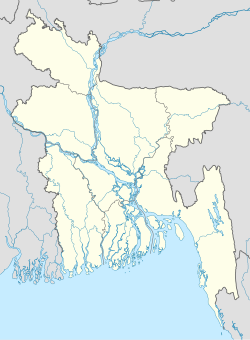Jaintiapur
|
Jaintiapur জৈন্তাপুর |
|
|---|---|
| Upazila | |
| Location in Bangladesh | |
| Coordinates: 25°7.5′N 92°7′E / 25.1250°N 92.117°ECoordinates: 25°7.5′N 92°7′E / 25.1250°N 92.117°E | |
| Country |
|
| Division | Sylhet Division |
| District | Sylhet District |
| Area | |
| • Total | 258.69 km2 (99.88 sq mi) |
| Population (2011) | |
| • Total | 121,458 |
| • Density | 470/km2 (1,200/sq mi) |
| Time zone | BST (UTC+6) |
| Website | Official Map of Jaintiapur |
Jaintiapur (Bengali: জৈন্তাপুর, Jotyintapur) is an Upazila of Sylhet District in the Division of Sylhet, Bangladesh.
Pan, Pani Nari- Ei tiney Jaintapuri- Betel, water and women, these three make Jaintapuri. That's the first line of a rhyme that has become something of a catchphrase among Sylhetis to describe Jaintapur, a historically rich upazila of Sylhet.
A long time ago, the present plain land was probably under water and part of a huge water body, which might have separated Jaintapur from Sylhet, historians say. Because of this geophysical condition, the region remained independent for a long time and was known as the Jaintia Kingdom. Jaintia was a hill kingdom of ancient Assam. In the sixteenth century, most of the greater Sylhet region was under the jurisdiction of Jaintia king who ruled from the capital Jaintapur. The inhabiting Khashia people (ethnic group) had a matriarchal society and its own language. Sometime around 1500, the then king Parbat Roy adopted his Sanskrit name. The king of Cooch Bihar conquered Jaintia sometime between 1548 and 1564. Late that century, the Jaintia kingdom was governed under the kingdom of Cachhar Raja. The Jaintia kingdom regained independence in 1605 with the help of Ahom Raja. Lakshmi Narayan was a strong king (1669-1697) who was famous for the construction of buildings using bricks at his capital at Jaintapur. The British East India Company drove the Jaintia king from the plains of Sylhet in1765. The kingdom lost its independence when the Burmese conquered Assam in 1824. Again the British drove the Burmese away while the kingdom's independence was restored in 1825. To facilitate their trade of limestone and canes in Sylhet, the East India Company annexed the Jaintia kingdom to their Bengal state in 1935.
According to the local legends and folk tales, from the seventh or eighth century, the Jaintapur kingdom came under the control of the Kamrup Kingdom and later the same year under the control Chandra and Varman rulers. After the fall of Varmans, the kingdom again went under the rule of the Deva dynasty for some time. Jayanta Roy, the last ruler of the Deva dynasty had a daughter named Joyonti, who was married to a son of Khashi chief-Landowar. Because of this marriage, the kingdom came under the ruling of the Khashis in around 1500. It remained as an independent kingdom under the Khashis till 1824.
There are still plenty of visitor attractions at the remains of Jaintapur, which include the temple of Jainteswari, the Rajbari (palace) and the monuments. These remnants, however, are now quite dilapidated. The palace built by the King Lakshmi Sinha (1670-1701) in 1680 is ruined. The main structure of the temple has also been heavily damaged. However, the temple area has a boundary wall now. Some of the ancient monuments at Jaintapur are sites of tremendous historical interest. The lone megalithic remains discovered so far in Bangladesh are located in Jaintapur. They are similar to the ones discovered in India.
...
Wikipedia

